-

人教版高中英语必修2Wildlife Protection说课稿3篇
When it comes to the students’ studying methods, I'd like to introduce my Ss first. The Ss have a good command of basic language points. They’re interested in learning English, and they take an active part in English class, so they will have fun in autonomous, cooperative and inquiry learning. I will just serve as a guide, showing them the way to explore how to make more progress in their English learning.Now it’s time for the most important stage of this lesson. My teaching procedures are arranged as follows:Step1.Leading-in (3 minute)Play a video of a wide variety of wildlife to introduce my topic. Step2. Speaking (12 minutes)We will use our textbook Page25. Let the Ss fast read the short paragraph to warm up. Ask them to talk about the report on some endangered wildlife in China with the dialogue patterns on the screen. Lastly, I will invite some groups to demonstrate their dialogues about saving wildlife in China.Step3.English play (3 minutes)Watch another video in praise of their excellent performance just now. It’s about Jack Chen’s(成龙)and Yang Ziqiong’s wildlife protection.Step4. Listening (twice 13 minutes)This time, I’ll ask the Ss to fill in the blanks of the monologue of the 2 movie stars above. Step5.Discussion (3 minutes)Which would you like to choose to wear, clothes made of cotton, artificial leather or animal skins? Why ?Step6. Summary (3 minutes)1. If there were no wildlife, there wouldn’t exist human beings. If the buying stops, the killing can, too.2. Animals are our friends. To love animals is to love ourselves. Stop hunting, killing and destroying wildlife.3. Let’s live in harmony with all the living things in the world. Step7. Music appreciation (3 minutes)Let the Ss appreciate the song Earth Song by Michael Jackson. Last but not the least, I will show you my blackboard design.

人教版高中英语必修4A taste of English Humor说课稿3篇
Then I would ask them to think of a funny English or Chinese and tell it to partners. While telling stories, they can use expressions and some acting to help make the story funny. 5 minutes would be given to do this.Those stories they told there will be the material for their writing. Soletting them tell it at first is helpful. And they can make a difference between telling a funny story and writing it down. Generally speaking, it is difficult forstudents to write well because they don’t know what to write and how to write. Asking them to tell their own stories at first can help them come up with what to write.After their telling, I would invite someone to share his/her story with all of us and I would write it down on the blackboard.This example story would be used as a sample to illustrate the format of funny story. Different from a story from teacher or textbook, a story from students can obviously become a interesting material to draw students’ attention.Then I would ask the whole class to put this story into several parts. It might be a little bit difficult for them. So I would ask them to find out whether all the sentences are necessary. After delete some sentences, there are 6 sentences left behind. Then they can easily put them into three parts. After interaction with students, I would teach them the right terms for each part and conclude the format of funny story.This step is the key and difficult point in my lesson. So I mainly usetask-based teaching method in this part and the task for students was divided into several stages. With the separated difficult level, students can find there are usually three parts in writing. They can also learn to write without the unnecessary parts in the process of analyzing. And then I wouldn’t rush to tell them the right terms to them directly. Instead, I would ask them to name them by their own. A confused mind is better for acquiring knowledge.While-writing:Then I would give students 7 minutes to write down this story, without other requirements.With all the preparations in pre-writing, students’ difficulties were cleared. So it would be much easier for them to write down the story within 7 minutes. There are no other requirements because students’ first writing is actually a drafting. It would be revise and edit several times later. Writing, as a skill

人教版高中英语必修4Women of achievement说课稿4篇
Good morning, distinguished judges:It’s my honor to talk about my teaching ideas with you. Today my topic is Women of Achievement. My presentation consists of six parts: the analysis of teaching material and student, teaching aims, key and difficult points, teaching and studying method, teaching procedures and blackboard design.First, let’s focus on the analysis of teaching material. This lesson is from New Senior English for China Student’s Book 4 Unit 1, the reading part. The main topic of the passage is the introduction of a student of Africanwildlife. After this lesson, the students will learn more information about her studying chimps in Africa, and their reading and speaking abilities can be developed as well.The next part is the analysis of students. My students are in senior high students. They have learnt English for many years, they’ve known many words and sentences, but their speaking and reading abilities are still not very good. So I will practice their speaking and reading abilities through different exercises.According to the New Standard Curriculum and the present situation, I set the teaching aims as follows: firstly, knowledge aims. Students can grasp some new words, such as worthwhile, move off. Moreover, students can understand the content of the passage and get familiar with the topic of studying chimps in wildlife. Secondly, ability aims. Students can use reading strategies such as skimming and scanning in reading process. Thirdly, emotional aims. Students can have the awareness of protecting animals and care about animals.Based on the above analysis, the key point of this lesson is to get the main idea and the detailed information from the passage; the difficult point is to talk about the wildlife protection and use reading strategies.

人教版高中英语必修3Festivals around the World说课稿3篇
Teaching plan for Unit 1 book3Good morning, teachers. It’s my great pleasure to be here because I can share my lesson with you and I can learn a lot from it. I’ll begin my lesson from the following four parts, the teaching material, the teaching methods, the studying methods and the teaching procedure.Firstly, let me talk about the teaching material. The content of my lesson is the reading passage festivals and celebrations of Unit 1 Festivals around the world. This passage is about festivals and celebrations. By studying this passage, we’ll enable the students to know that festivals exit everywhere, and many of festivals in different countries celebrate similar ideas. As we all know, the reading passage is the center of each unit. If the Ss can learn it well, it will be helpful to make the Ss learn the rest of this unit.After studying the teaching material, I think the teaching aims are as the followings:1. Knowledge aims:(1) The Ss can master the usage of the important words andexpressions.(2)The Ss can use the __________________ (grammar) in the proper situation.Make students know about the festivals all over the world and the detail of the festivals, such as origin, content, and the date of the holiday festivals.2. Ability aims:(1) Students can talk about festivals and celebrations in English(2) To improve the student’s reading ability, especially their skimming and scanning ability.3. Emotion aims:Make the Ss know about the foreign festivals, and respect other countries’ custom.Next, let’s come to the important points and the difficult points.The important point is how to make the Ss understand the text better and the difficult point is how can they talk about it. secondly, Teaching Methods:1. task-based Language Teaching2. Computer assisted language teaching.3. question-and–answer methodThirdly, Studying Methods:

人教版高中英语必修3Healthy Eating说课稿4篇
Language learning needs a context, which can help the learners to understand the language and then can product comprehensible output, so computer has the advantages to make the materials attractive.Part 3 Learning MethodsTask-based, self-dependent and cooperative learningPart 4 Teaching ProcedureStep One Lead-in“Interest is the best teacher.” Therefore, at the very beginning of the class, I should spark the students’ mind to focus on the centre topic “the band”. I’ll show some pictures of food to attract their attention and then bring some questions.Question:What kind of food they like?What should go into a good meal?The answers must relate to the diet. After this, the students will be eager to know something about a balance diet and this is the very time to naturally lead the class into Step 2Step 2 Reading for information: skimming and scanning In this step, I use Task-based Language Teaching method, which can give students a clear and specific purpose while skimming and scanning the context.Task 1 General ideaThe students will be asked to just glance at the title and the pictures of the passage, and then guess what they will read in the text. And they’ll be divided into groups of four to have a discussion.The purpose is to inspire the students to read actively, not passively. In addition, the task is to develop the students’ reading skill by making prediction and to encourage the students to express their thoughts in English and cooperate with each other.Task 2 Main idea of each paragraphCooperative learning can raise the students’ interest and create an atmosphere of achievement. Based on this theory, I divide the whole class into 4 groups to skim the whole text and get the main idea of each paragraph.

人教版高中英语必修4Working The Land说课稿3篇
Knowledge objectives:(1) to make Ss grasp the usage of words, expressions and sentence structures: statistics, struggle, thanks to, rid of, some patterns for persuasion, the “ing” form as subject and object;(2)to use learnt knowledge to persuade sb.Ability objectives:(1) to develop Ss’ reading skills(skimming, scanning, word guessing);(2) to improve Ss’ speaking, communicating and cooperating skills.Emotional objectives:to make Ss know the contribution of Yuan,and learn his spirit and his simple life time.Teaching important and difficult points:(1) some words, expressions and sentence structures mentioned above;(2)the content of the text;(3)training their reading and speaking skills.Teaching methods: CLT, TBLT,QT.Learning strategies: CLS, QLS, TBLS.Teaching procedures:Step 1 lead-in: (1) teacher plays a piece of recent news from CCTV about the harvest of the super hybrid rice, and ask students whether they know Yuan or not, and talk about him and his contribution.(2)Brain storm: let Ss describe Yuan in their minds including his appearance, his living condition and so on.Step 2 fast reading tasks:(1)teacher introduces Yuan and super hybrid rice(2)make Ss read the text as fast as possible with questions. Such as: what’s the general ideaof this passage? What’s Yuan’ dream? (skimming and scanning skill)Step 3 intensive reading tasks(1)let Ss read the text silently, find topic sentence of each paragraph and draw the difficult sentences and the knowledge what they don’t understand.(words guessing)(2)teacher and Ss talk about the important words, expressions and sentences together, and ask Ss to retell the content of the text.(summarizing and paraphrasing)(3)teacher summarize this part.(4) read again following the courseware.

人教版高中英语必修5First aid说课稿6篇
In this class, I have 3 teaching aims, that is, knowledge aims, ability aims and emotion aims.1) Knowledge-Teach students new words and expressions, such as temporary, bleed,sprain choke, first aid, fall ill and so on.-Enable students to have a better understanding for some basic knowledge of first aid.2) Ability-Train students’ speaking, reading and writing abilities by different teaching activities, such as skimming, comprehending, team work, role play, retelling and writing.-Develop students’ reading strategy on how to move general idea to specific information.3) Emotion-Promote students’ awareness of giving first aid.- Cultivate students’ creativities.Then let’s come to my teaching methods and activities.III. Teaching methods and activities:To achieve different teaching aims, various kinds of teaching methods and activities will be adopted throughout this period, such as TBL (task-based learning), skimming, team work, brainstorm and others, which can offer students opportunities to fulfill tasks in which they can use language to achieve a specific outcome.IV. Teaching aids:Computer and blackboardV. Teaching important points:1) Make students have a clear mind for the structure of the text.2) Help students understand the theme of the text.VI. Teaching difficulties:1) So many new words may affect students’ understanding.2) How to get students to know about the functions of the skin and thecauses, characteristics and treatments for different degree burns,and the knowledge about giving first aid. VII. Blackboard design:

人教版高中英语必修5Great scientists说课稿4篇
通过写文章梗概,培养学生综合运用语言的能力,学习用恰当的英语描述科学家的故事。这是本课的教学难点。教师可以使用完形填空的方式来帮助学生整理语篇,从而来降低难度。本课的教学重点的突破方法是:在阅读前,让学生初步了解得出科学观点所需要的基本程序,从而轻松而自然地导入文章的阅读;在阅读过程中,由易到难设计快速阅读和精读的问题,层层推进各种阅读活动,让学生对阅读内容从整体感知到细节理解,最后深层读懂整篇文章,同时加强阅读策略的指导,让每个学生都主动参与课堂教学活动,最终达到提高阅读能力的目的。Step 4 Post-readingGroup Activities四人小组共同合作,在老师的适当指导下,就以下2个问题展开讨论,让学生就所知、所学、所感和所想融入话题,然后抽若干同学代表作小组发言。1. What do you think about John Snow, and what should we learn from him?2. Cholera was 19th century disease, which two diseases are similar to cholera today? Why?

人教版高中英语必修5Making the news说课稿4篇
今天我们来介绍一下必修五第四单元的授课方式。这个单元的题目是Making the news。应该是学生比较感兴趣的话题,学生往往对新闻工作充满好奇,所以我们可以利用这个机会多设计一些师生互动和学生互动,来激发起学习的积极性,提高学习效率。同时我们可以利用这个单元不仅帮助学生掌握语言知识,培养语言能力,同时让其了解新闻工作的重要性,培养起社会智能感。这个单元分为六个课时,它的教学目标是这样的:语言目标是掌握词汇表中的常用单词和短语,掌握倒装句的一些基本用法。 技能目标是能初步掌握约会的基本句型并在真实的场景下正确运用。新闻报道类文章的写作技能。采访的基本规范和沟通技能。情感目标是对新闻报道的客观性和真实性有更好的理解。对新闻记者的职业有更深入的了解,并能体会其工作的重要性。下面我们来介绍一下第一课时的授课方式,第一课的教学目标是这样的第一课时的教学目标语言目标:单词:Occupation, journalist, editor, photographer, curious, personality, enthusiasm

人教版高中英语必修5The United Kingdom说课稿4篇
Teaching Aims:Knowledge 1. Get the students to learn the useful new words and expressions in this section. Aims:2. Let the students learn about how the UK was formed and the four groups of invaders.1. Develop students’ reading ability and let them learn different Ability reading skills. Aims:2. Enable students to learn to talk about the United Kingdom and the Union Jack Emotional 1. Let students know more about the UK2. Develop students’ sense of cooperative learning Aims:Teaching Important Points:1. Let the students learn about the countries of the United Kingdom and the Union Jack2. Get the students to read the passage and know about how the UK was formed and the four groups of invaders.3. Have the students learn different reading skills.Teaching Difficult Ponts:1. Develop students’ reading ability.2. Enable students to talk about the United Kingdom and the Union Jack.3. Let students learn how the UK was formed geographically and historically.Teaching Methods:Showing pictures, asking, exercising, listening, reading etc.Teaching Aids:A computer,a projector and a blackboard.Teaching Procedures: 1) Show a map of the world, ask students the following questions:Where is the UK?What’s the full name of the UK?2) Ask the students work in pairs to do the quiz on Page 9.Do you want to test how many things you know about the United Kingdom? Let’s have a small test.Using the map on P9, students answer the following questions:?How many countries does the UK consist of? What are they??England is divided into three main areas. Do you know what they are? 1) Scanning (10Minutes )Let the students hold the questions asked in pre-reading and read the passagequickly and then let them do the following exercise.Join lines to the right answer.
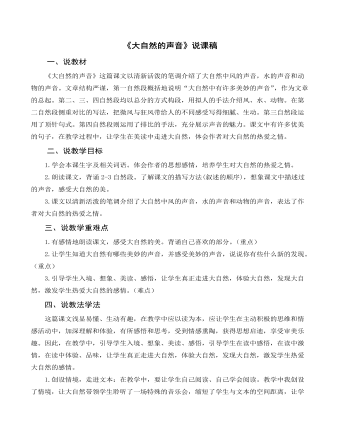
部编人教版三年级上册《大自然的声音》说课稿
四、说教法学法这篇课文浅显易懂、生动有趣,在教学中应以读为本,应让学生在主动积极的思维和情感活动中,加深理解和体验,有所感悟和思考,受到情感熏陶,获得思想启迪,享受审美乐趣。因此,在教学中,引导学生入境、想象、美读、感悟,引导学生在读中感悟,在读中激情,在读中体验、品味,让学生真正走进大自然,体验大自然,发现大自然,激发学生热爱大自然的感情。 1.创设情境,走进文本:在教学中,要让学生自己阅读、自己学会阅读。教学中我创设了情境,让大自然带领学生聆听了一场特殊的音乐会,缩短了学生与文本的空间距离,让学生置身于自然之中,俨然是大自然中的一员,在情境中感知,体会到大自然声音的美妙,与文本产生了共鸣,激发了学生的学习兴趣,让学生成为学习的主人。 2.美读感悟,放飞想象:在教学中始终以“大自然中这些声音真是太美妙了”贯串始终,重点指导学生美读课文,抓住描写声音的词,边读边思考,大胆的展开想象,有感情地读,配乐读,自由读,分组读,师生合读,全班齐读,在读中生成自己独特的感受、体验和理解,感受风声的美妙,水声的有趣,动物声的快乐,同时培养学生的语感。 3.拓展延伸,提高能力:布置学生课后在大自然找一些新发现,拓展学生的学习空间,扩大视野,增长知识。让学生在课内外的学习中提高语文素养。
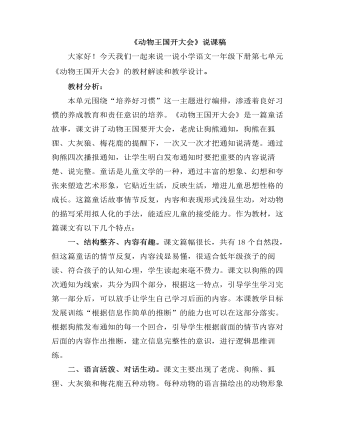
部编人教版一年级下册《动物王国开大会》说课稿
二、语言活泼、对话生动。课文主要出现了老虎、狗熊、狐狸、大灰狼和梅花鹿五种动物。每种动物的语言描绘出的动物形象符合人们心目中动物形象。如“拿着喇叭大声喊……一连喊了十遍”,伸了伸舌头,做了个鬼脸,连忙说:“对,对,对!”“捶捶自己的脑袋”勾画出了一个拿着喇叭大声喊、可爱又憨厚的狗熊。又如老虎的语言中“快去”“再去”等词语体现了老虎是森林大王的威严。文中动物的语言有特点,标点也有特点。如狗熊四次发布通知,都是以感叹号结尾,带有命令、感召的语气,随着内容越来越具体、清楚,语气也越来越强烈,最后一次通知中出现了2个感叹号!祈使句主要集中在狗熊和老虎说的话中。这是狗熊四次发布通知的内容,这四次通知,带有号召、命令的语气,随着发布的内容越来越具体、清楚,语气也越来越强烈!
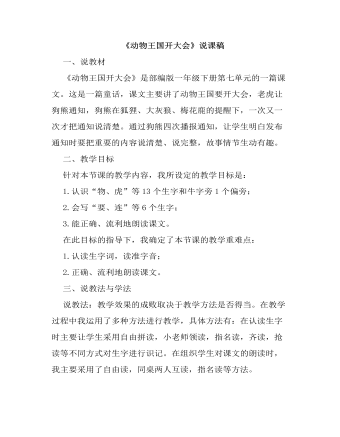
部编人教版一年级下册《动物王国开大会》(说课稿)
三、说教法与学法说教法:教学效果的成败取决于教学方法是否得当。在教学过程中我运用了多种方法进行教学,具体方法有:在认读生字时主要让学生采用自由拼读,小老师领读,指名读,齐读,抢读等不同方式对生字进行识记。在组织学生对课文的朗读时,我主要采用了自由读,同桌两人互读,指名读等方法。说学法:根据一年级学生特点及本节课的目标,本节课主要指导学生采用自主探究、合作交流、成果展示法的学习方法,开展学习活动。四、说教学过程为了更好、更有效地落实教学目标,突出重点,突破难点,我的教学流程有以下四大板块。(一) 情境导入,激发兴趣1.导课环节,首先利用多媒体向学生播放老虎、狗熊、狐狸、梅花鹿等图片,并配以音乐,让学生根据图片说出动物的名字,在轻松、愉悦的氛围中进入新课的学习——《动物王国开大会》。2.在板书课题时,相机教学“动物”的“物”字,在这里要读轻声,认识牛字旁。3.再次齐读课题。
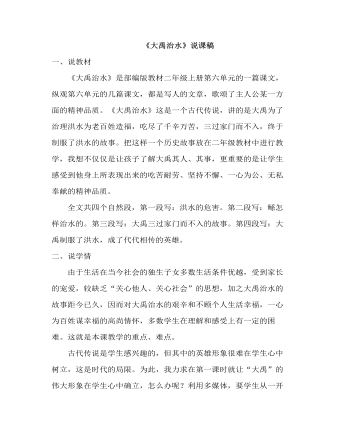
部编人教版二年级上册《大禹治水》说课稿
一、说教材《大禹治水》是部编版教材二年级上册第六单元的一篇课文,纵观第六单元的几篇课文,都是写人的文章,歌颂了主人公某一方面的精神品质。《大禹治水》这是一个古代传说,讲的是大禹为了治理洪水为老百姓造福,吃尽了千辛万苦,三过家门而不入,终于制服了洪水的故事。把这样一个历史故事放在二年级教材中进行教学,我想不仅仅是让孩子了解大禹其人、其事,更重要的是让学生感受到他身上所表现出来的吃苦耐劳、坚持不懈、一心为公、无私奉献的精神品质。全文共四个自然段,第一段写:洪水的危害。第二段写:鲧怎样治水的。第三段写:大禹三过家门而不入的故事。第四段写:大禹制服了洪水,成了代代相传的英雄。
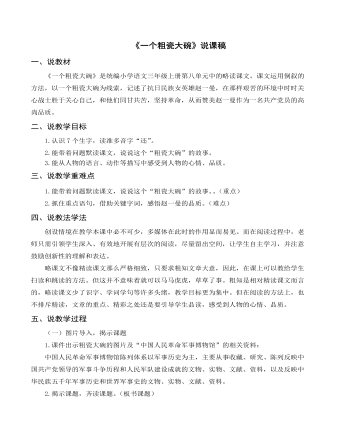
部编人教版三年级上册《 一个粗瓷大碗》(说课稿)
三、说教学重难点1.能带着问题默读课文,说说这个“粗瓷大碗”的故事。。(重点)2.抓住重点语句,借助关键字词,感悟赵一曼的品质。(难点)四、说教法学法创设情境在教学本课中必不可少,多媒体在此时的作用显而易见。而在阅读过程中,老师只需引领学生深入、有效地开展有层次的阅读,尽量留出空间,让学生自主学习,并注意鼓励创新性的理解和表达。 略课文不像精读课文那么严格细致,只要求粗知文章大意,因此,在课上可以教给学生扫读和跳读的方法。但这并不意味着就可以马马虎虎,草草了事。粗知是相对精读课文而言的,略读课文少了识字、学词学句等许多头绪,教学目标更为集中。但在阅读的方法上,也不排斥精读,文章的重点、精彩之处还是要引导学生品读,感受到人物的心情、品质。
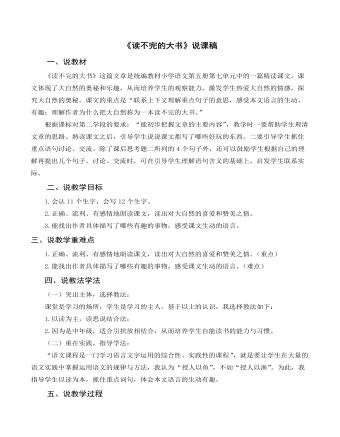
部编人教版三年级上册《读不完的大书》说课稿
一、说教材《读不完的大书》这篇文章是统编教材小学语文第五册第七单元中的一篇精读课文。课文体现了大自然的奥秘和乐趣,从而培养学生的观察能力,激发学生热爱大自然的情感,探究大自然的奥秘。课文的重点是“联系上下文理解重点句子的意思,感受本文语言的生动、有趣;理解作者为什么把大自然称为一本读不完的大书。”根据课标对第二学段的要求:“能初步把握文章的主要内容”,教学时一要帮助学生理清文章的思路。熟读课文之后,引导学生说说课文都写了哪些好玩的东西。二要引导学生抓住重点语句讨论、交流。除了课后思考题二所列的4个句子外,还可以鼓励学生根据自己的理解再提出几个句子。讨论、交流时,可在引导学生理解语句含义的基础上,启发学生联系实际。二、说教学目标1.会认11个生字,会写12个生字。2.正确、流利、有感情地朗读课文,读出对大自然的喜爱和赞美之情。3.能找出作者具体描写了哪些有趣的事物,感受课文生动的语言。
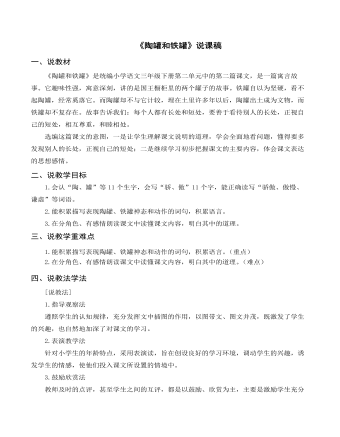
(说课稿)部编人教版三年级下册《 剃头大师》
三、说教学重难点1.能积累描写表现陶罐、铁罐神态和动作的词句,积累语言。(重点)2.在分角色、有感情朗读课文中读懂课文内容,明白其中的道理。(难点)四、说教法学法[说教法]1.指导观察法遵照学生的认知规律,充分发挥文中插图的作用,以图带文、图文并茂,既激发了学生的兴趣,也自然地加深了对课文的学习。 2.表演教学法 针对小学生的年龄特点,采用表演读,旨在创设良好的学习环境,调动学生的兴趣,诱发学生的情感,使他们投入课文所设置的情境中。 3.鼓励欣赏法 教师及时的点评,甚至学生之间的互评,都是以鼓励、欣赏为主,主要是激励学生充分地展示才能,满足他们希望得到赞许,体会成功的心理特点,激起学生学习的欲望,增强朗读的信心。
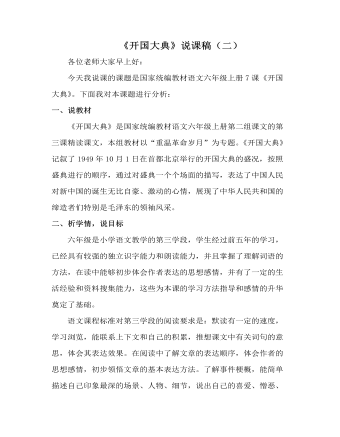
部编人教版六年级上册《开国大典》说课稿(二)
一、说教材《开国大典》是国家统编教材语文六年级上册第二组课文的第三课精读课文,本组教材以“重温革命岁月”为专题。《开国大典》记叙了1949年10月1日在首都北京举行的开国大典的盛况,按照盛典进行的顺序,通过对盛典一个个场面的描写,表达了中国人民对新中国的诞生无比自豪、激动的心情,展现了中华人民共和国的缔造者们特别是毛泽东的领袖风采。二、析学情,说目标六年级是小学语文教学的第三学段,学生经过前五年的学习,已经具有较强的独立识字能力和朗读能力,并且掌握了理解词语的方法,在读中能够初步体会作者表达的思想感情,并有了一定的生活经验和资料搜集能力,这些为本课的学习方法指导和感情的升华奠定了基础。
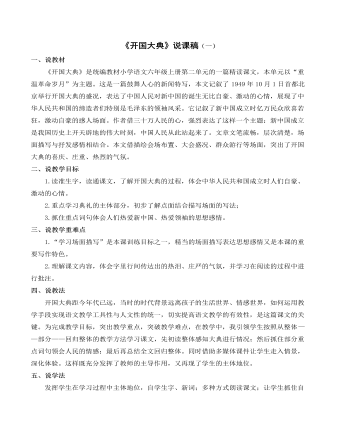
部编人教版六年级上册《开国大典》说课稿(一)
四、说教法 开国大典距今年代已远,当时的时代背景远离孩子的生活世界、情感世界,如何运用教学手段实现语文教学工具性与人文性的统一,切实提高语文教学的有效性,是这篇课文的关键。为完成教学目标,突出教学重点,突破教学难点,在教学中,我引领学生按照从整体——部分——回归整体的教学方法学习课文,先初读整体感知大典进行情况;然后抓住部分重点词句领会人民的情感;最后再总结全文回归整体。同时借助多媒体课件让学生走入情景,深化体验。这样既充分发挥了教师的主导作用,又再现了学生的主体地位。 五、说学法 发挥学生在学习过程中主体地位,自学生字、新词;多种方式朗读课文;让学生抓住自己感兴趣的场景,朗读,想象,谈体会,即通过谈——读——想——体这四个环节,来学习课文,这样既培养了学生的自学能力,又充分发挥了学生的想象力,让学生有效地展开了与文本的对话。
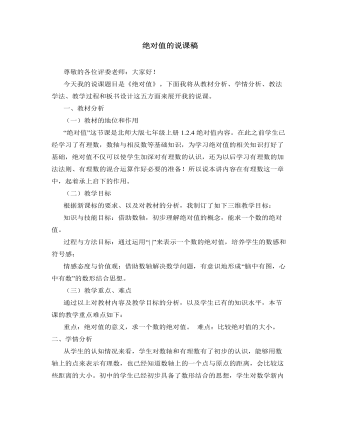
北师大初中数学七年级上册绝对值的说课稿
(三)学以致用,巩固新知为巩固本节的教学重点我再次给出三道问题: 1)绝对值是7的数有几个?各是什么?有没有绝对值是-2的数?2)绝对值是0的数有几个?各是什么? 3)绝对值小于3的整数一共有多少个?先让学生通过小组讨论得出结果,通过以上练习使学生在掌握知识的基础上达到灵活运用,形成一定的能力。(四)总结归纳,知识升华小结时我也将充分发挥学生学习的主动性,发挥教师在教学的启发引导作用,和学生一起合作把本节课所学的内容做一个小结。(五)布置作业,拓展新知布置作业不是目的,目的是使学生能够更好地掌握并运用本节课的内容。所以我会布置这样一个作业:请学生回家在父母的帮助下,找出南方和北方各三个城市的温度,并比较这些温度的大小,并写出每个温度的绝对值进行比较

